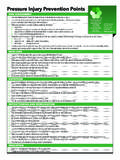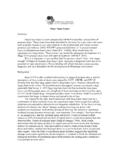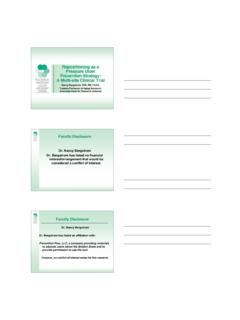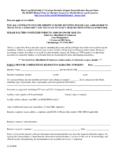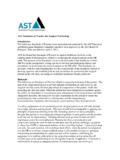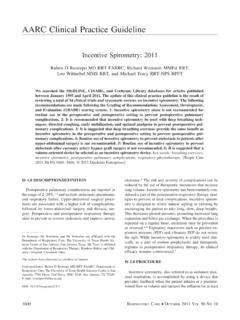Transcription of Prevention and treatment of pressure ulcers: …
1 National pressure ulcer Advisory Panel Registered Nurse Competency-based Curriculum: pressure ulcer Prevention Barbara Pieper, PhD, RN, CWOCN, ACNS-BC, FAAN. Based on: National pressure ulcer Advisory Panel and European pressure ulcer Advisory Panel. Prevention and treatment of pressure ulcers: Clinical practice guideline. Washington DC: National pressure ulcer Advisory Panel; 2009. May 29, 2013. Major Examples: Content Examples: Content Topic Examples: Teaching Possible references in Competencies/Objectives Objective(s) Method addition to the NPUAP. /EPUAP Prevention and treatment of pressure ulcers: Clinical practice guideline, 2009. Many of the references match more than one objective, but are listed in this document one time only. Understands pressure ulcer Define pressure ulcer Prevalence definition and Lecture Dealey C, Chambers T, incidence and prevalence incidence and prevalence. formula Practice with data Beldon P, Benbow M, Participates in data Incidence definition and collected within the Fletcher J, Fumarola S, collection for pressure ulcer formula institution or developed Guy H, Nixon J, Price J, incidence and prevalence.
2 For practice. Purser K, Stubbs N, Way Set up an agency program L, Weafer K; Members of to measure pressure ulcer TVS pressure ulcer incidence and prevalence Working Group. Case studies Achieving consensus in Discussion/analysis of pressure ulcer reporting. J. 1. articles about incidence Tissue Viability. and prevalence. 2012;21(3):72-83. Discussion/analysis of the agency's pressure ulcer He J, Staggs VS, prevalence and incidence. Bergquist-Beringer S, Develop methods to Dunton N. Unit-level time decrease pressure ulcer trends and seasonality in incidence. the rate of hospital- Test: multiple choice, acquired pressure ulcers true/false, etc. in US acute care hospitals. Develop research/data Res Nurs Health. collection method for 2013;36(2):171-80. institutional pressure ulcer prevalence and incidence Hendrichova I, Castelli studies M, Mastroianni C, Piredda M, Mirabella F, Surdo L, De Marinis MG, Heath T, Casale G. pressure ulcers in cancer palliative care patients.
3 Palliat Med. 2010;24(7):669-73. Kottner J, Wilborn D, Dassen T. Frequency of pressure ulcers in the paediatric population: a literature review and new empirical data. Int J Nurs Stud. 2010;47(10):1330- 2. 40. Berlowitz D. Prevalence, incidence, and facility acquired rates. In Pieper B. (Ed.) with the National pressure ulcer Advisory Panel (NPUAP). (2012). pressure ulcers: Prevalence, incidence, and implications for the future. Washington, DC: NPUAP, p 19-24. Identify etiologic factors Identify risk factors for Impaired mobility Lecture Benoit R, Mion L. Risk contributing to pressure pressure ulcer Impaired activity Registered dietitian as factors for pressure ulcer ulcer occurrence. development. Nutritional indicators ( guest lecturer development in critically Common geriatric Independent learning Ill patients: a conceptual syndromes impacted by modules model to guide research. primary and secondary Case studies Res Nurs Health.)
4 Nutrition preventions Develop games based on 2012;35(4):340-62. Characteristics of content undernutrition and Poster with risk factors White, J. Consensus malnutrition, Signs of Internet-based educational Statement: AND and vitamin and mineral programs ASPEN: characteristics deficiencies) Simulation laboratory recommended for the Factors affecting patient practice identification and perfusion and Patient-centered rounds on documentation of adult oxygenation (diabetes; unit malnutrition cardiovascular Institution based (undernutrition.) J Acad instability/norepinephrine discussion on pressure Nutr Diet 2012, use; low blood pressure ; ulcer risk factors 3. ankle brachial index; Test: multiple choice, 730-738. oxygen use; smoking) true/false, etc. Skin moisture T rm J, Winblad U, Advanced age Cederholm T, et al. Does Shear undernutrition still prevail Sensory perception among nursing home General health status residents?
5 Clin Nutr. 2013. Persons of color: race Aug; 32(4):562-8. and ethnicity Kane RL, Talley KM, Shamliyan T. et al. Common Syndromes in Older Adults Related to Primary and Secondary Prevention . Evidence Report/Technology Assessment No. 87. AHRQ. Publication No. 11-05157- EF-1. Rockville, MD: Agency for Healthcare Research and Quality; July 2011. Bernabe KQ. pressure ulcers in the pediatric patient. Curr Opin Pediatr. 2012;24(3):352- 6. 4. Black JM, Edsberg LE, Baharestani MM, Langemo D, Goldberg M, McNichol L, Cuddigan J;. National pressure ulcer Advisory Panel. pressure ulcers: avoidable or unavoidable? Results of the National pressure ulcer Advisory Panel Consensus Conference. Ostomy Wound Manage. 2011;57(2):24-37. Black J, Baharestani M, Black S, Cavazos J, Conner-Kerr T, Edsberg L, Peirce B, Rivera E, Schultz G. An overview of tissue types in pressure ulcers: a consensus panel recommendation. Ostomy Wound Manage. 2010;56(4):28-44.
6 Cakmak SK, Gul U, et al. Risk factors for pressure ulcers. Adv Skin Wound Care. 2009;22;412-415. Doughty D, Junkin J, 5. Kurz P, Selekof J, Gray M, Fader M, Bliss DZ, Beeckman D, Logan S. Incontinence-associated dermatitis: consensus statements, evidence- based guidelines for Prevention and treatment , and current challenges. J. Wound Ostomy Continence Nurs. 2012;39(3):303-15; quiz 316-7. Fogerty MD, Guy J, et al. African Americans show increased risk for pressure ulcers: a retrospective analysis of acute care hospitals in America. Wound Rep Reg. 2009;17:678-684. Guihan M, Bombardier CH. Potentially modifiable risk factors among veterans with spinal cord injury hospitalized for severe pressure ulcers: a descriptive study. J Spinal 6. Cord Med. 2012;35(4):240-50. Hanson D, Langemo DK, Anderson J, Thompson P, Hunter S. Friction and shear considerations in pressure ulcer development. Adv Skin Wound Care. 2010;23(1):21-4.
7 Masotti P, McColl MA, Green M. Adverse events experienced by homecare patients: a scoping review of the literature. Int J. Qual Health Care. 2010;22(2):115-25. Sieggreen M. pressure ulcers in persons of color: race and ethnicity. In Pieper B. (Ed.) with the National pressure ulcer Advisory Panel (NPUAP). (2012). pressure ulcers: Prevalence, incidence, and implications for the future. Washington, DC: NPUAP, p 147-150. 7. VanGilder C, Amlung S, et al. Results of the 2008- 2009 international pressure ulcer prevalence survey and a 3-year, acute care, unit-specific analysis. Ostomy Wound Manage. 2009;55:39-45. Wound Ostomy and Continence Nurses Society. Guideline for Prevention and treatment of pressure ulcers. Mount Laurel, NJ, 2010. Conduct a structured risk Select a risk assessment Braden Scale Lecture Baharestani MM, Ratliff assessment on admission, method or tool appropriate Braden Q Scale Independent learning CR. pressure ulcers in and repeat as regularly and to the population Norton Scale modules neonates and children: an as frequently as required ( , Braden Scale, Braden Case studies NPUAP White Paper.)
8 Adv by patient acuity and Q, & Norton Scale). DVD showing patient to Skin Wound Care. setting. Use a structured approach rate for pressure ulcer risk. 2007;20:2008-220. to risk assessment to Discussion of difficulties identify individuals at risk in using a risk assessment Bergquist-Beringer S, of developing pressure tool. Daley CM. Adapting ulcers. Develop decision tree on pressure ulcer Prevention Calculate an individual's how to respond to risk for use in home health pressure ulcer risk assessment tool's findings care. J Wound Ostomy assessment score. Poster showing risk Continence Nurs. Interpret the significance of assessment tool 2011;38(2):145-54. the pressure ulcer risk Observation and 8. score. evaluation of clinical use Bolton L. Which pressure Use professional judgment of risk assessment tool. ulcer risk assessment in evaluating risk Simulation laboratory scales are valid for use in assessment scores and experience with risk clinical settings.
9 J Wound individual risk factors in assessment. Ostomy Continence Nurs. the context of the 2007;34:368-381. individual's goals and needs. Denby A, Rowlands A. Reassess pressure ulcer risk Stop them at the door . as significant changes should a pressure ulcer occur in a patient's health Prevention protocol be status. implemented in the emergency department. J. Wound Ostomy Continence Nurs. 2010;37:35-38. Gadd MM. Preventing hospital-acquired pressure ulcers: improving quality of outcomes by placing emphasis on the Braden subscale scores. J Wound Ostomy Continence Nurs. 2012;39(3):292-4. Niederhauser A, VanDeusen Lukas C, Parker V, Ayello EA, Zulkowski K, Berlowitz D. Comprehensive 9. programs for preventing pressure ulcers: a review of the literature. Adv Skin Wound Care. 2012;25(4):167-88; quiz 189-90. Ensure that a complete Conduct a thorough skin Body areas critical for Lecture Black J, Baharestani M, et skin assessment is part of assessment.
10 Assessment Independent learning al. An overview of tissue the risk assessment Assess skin on admission Blanching modules types in pressure ulcers: a screening policy in place and routinely thereafter. Edema Pictures showing pressure consensus panel in all health care settings. Inspect skin at bony Induration changes on light and recommendation. Ostomy prominences and other Color and darkly darkly pigmented skin. Wound Manage. areas of exposure to pigmented skin DVD of risk assessment 2010;56:28-44. etiologic factors. Pain tools Clinical practice Able to identify blanching pressure ulcer stages Pictures showing pressure Black J, Langemo D. response, localized heat, Documentation of skin damage from mechanical pressure ulcer edema, and induration. and pressure ulcers devices staging/categorization. In Identify issues in the skin Role play skin assessment Pieper B. (Ed.) with the assessment of individuals and documentation National pressure ulcer with darkly pigmented Test: multiple choice, Advisory Panel (NPUAP).
